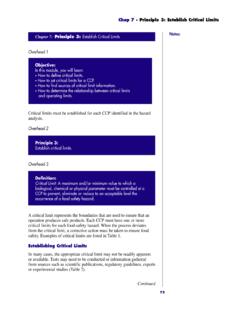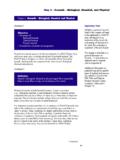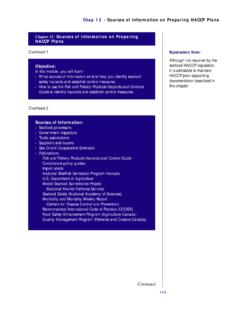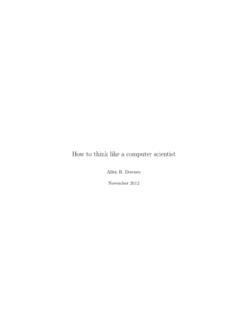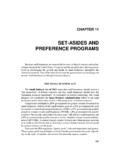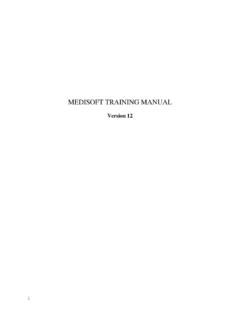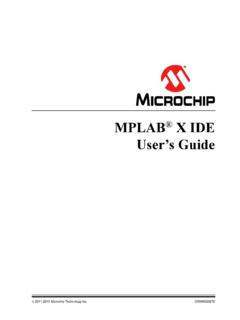Transcription of Chapter 9: Principle 5: Corrective Actions
1 Chap 9 - Principle 5: Corrective Actions91 Explanatory Note: Corrective Actions areimplemented whenmonitoring results indicatea deviation from criticallimits. Effective correctiveactions depend heavily onan adequate 9: Principle 5: Corrective ActionsOverhead 1 Overhead 2 Corrective Actions must be taken when critical limits at a CCP have beencompromised. When possible, these Actions should be predeterminedwhen developing the HACCP 3 When critical limits are violated at a CCP, the predetermined, documentedcorrective Actions should be instituted. These Corrective Actions shouldstate procedures to restore process control and determine the safedisposition of the affected product. It may be possible, and is alwaysdesirable, to correct the problem on the action options include: isolating and holding product for safety evaluation.
2 Diverting the affected product or ingredients to another line wheredeviation would not be considered critical. reprocessing. destroying :In this module, you will learn: The definition of Corrective Actions , Procedures for Corrective action and Record-keeping requirements for Corrective 5:Establish Corrective : Corrective action : Procedures to be followed when a deviation 9 - Principle 5: Corrective Actions92 Notes:The primary objective is to establish a HACCP program that permits rapididentification of deviations from a critical limit. The sooner the deviationis identified, the more easily Corrective Actions can be taken and thegreater the potential for minimizing the amount of noncompliant individual who has a thorough understanding of the process, productand HACCP plan and who has the authority to make decisions needs to beassigned the responsibility of making Corrective Corrective action plans must: Correct and eliminate the cause of the noncompliance to assure that theCCP is brought back under control.
3 Segregate, assess and determine the disposition of the Corrective Actions taken must be documented. Documentation willassist the firm in identifying recurring problems so that the HACCP plancan be modified. Additionally, Corrective action records provide proof ofproduct of Corrective ActionsThere are two components of Corrective Actions : 1) to correct andeliminate the cause of the deviation and restore process control and2) to identify the product that was produced during the process deviationand determine its 4 Correct and Eliminate the Cause of the Deviation and RestoreProcess ControlCorrective Actions must bring the CCP back under control. A correctiveaction should take care of the immediate (short-term) problem as well asprovide long-term solutions. The objective is to implement a short-termfix so that control can be re-established and the process started again assoon as possible without further process action Components: To correct and eliminate the cause of the deviation and restoreprocess control.
4 To identify the product that was produced during the processdeviation and determine its 9 - Principle 5: Corrective Actions93 ContinuedIt may be necessary to determine the cause of the deviation to preventfuture recurrence. A critical limit failure that was not anticipated orreoccurs should result in an adjustment to the product or process or are-evaluation of the HACCP outcome of the re-evaluation may be a decision to modify theHACCP plan. A permanent solution to eliminating or minimizing theinitial cause or causes for the process deviation should be implemented ifnecessary. Specific instructions for Corrective Actions must be available toplant workers and should be part of the documented HACCP plan. Identify the Product that was Produced During the Process Deviationand Determine the DispositionWhen a deviation occurs, identify nonconforming product.
5 There are foursteps that may be used for determining product disposition and develop-ing a Corrective action 5 Explanatory Note:If a product is to be testedand released, the samplingmethod is highly use of a faulty samplingprotocol can result inaccepting, rather thanrejecting, an undesirableproduct. The limits ofsampling plans must beunderstood. It may beprudent to consult an Note:It is important to ensure thatany reworking does not resultin the creation of a newhazard. Of primary concernare toxic materials, includingheat-stable biological must be realized thatreworked product is stillsubject to regulatory scrutinyand that reworking mustresult in a safe Steps:A. Step One: Determine if the product presents a safety hazard:a. Based on expert Based on physical, chemical or microbiological Step Two: If no hazard exists based on the evaluations inStep 1, the product may be Step Three: If a potential hazard exists (based on theevaluations in Step 1), determine if the product can be:a.
6 Diverted for a safe Step Four: If potentially hazardous product cannot be handledas described in Step 3, the product must be destroyed. This isusually the most expensive option and is usually regarded asthe last :Chap 9 - Principle 5: Corrective Actions94 Notes: Corrective action Format ExamplesCorrective Actions are usually written in an if/then format. The if part of the Corrective action describes the condition and the then partdescribes the action taken. For example:Overhead 6 Overhead 7 Overhead 8IF deviation:Temperature of milk at pasteurizerdrops below critical Corrective action :Milk flow is diverted until temperaturerecovers. Diverted product isrepasteurized. Check the operation ofthe heating/cooling units to determinethe reason for the temperaturedeviation that caused the flowdiversion.
7 Repair if necessary,re-establish control and deviation:Product ( , hot smoked fish)does not reach required internaltemperature for the required Corrective action :Recook or destroy deviation:Mahi-mahi held at elevatedtemperature for excess time period(temperature limit exceeded, possibleelevated histamine level).THEN Corrective action :Bury product in ice, place on holdand conduct sensory analysis andhistamine test. Determine the reasonfor the process delay. Prevent Note:During the process, it ispossible to extend the cooktime until the desired internaltemperature is reached forthe required time. However,this would be a processadjustment rather than acorrective 9 - Principle 5: Corrective Actions95 Corrective action RecordsPredetermined Corrective Actions are written into the HACCP plan. Whencritical limits are exceeded and a Corrective action occurs, it is Corrective - action report form is Corrective - action report should contain the following:a.
8 Product identification ( , product description, amount of producton hold).b. Description of the Corrective action taken including final disposition of the Name of the individual responsible for taking the Corrective Results of the evaluation when plan records could contain a separate file in which all deviationsand corresponding Corrective Actions are maintained in an organizedfashion. Corrective Actions are recorded in column 8 of the HACCP plan form. Following is the Corrective Actions for the IQF 9 ContinuedHACCP Plan FormCorrective Actions : 1. 2. 3. 4. 5. 6. Hazard CriticalMonitoringCorrective Verification RecordsLimitsWhat How Frequency WhoAction(s)Specify the Corrective - action procedures for each Note:The Corrective actionrecording should be closelylinked with the correspondingmonitoring that recorded adeviation.
9 Recommendedapproaches include recordingthe monitoring and correctiveactions on the same form,piece of paper, or 9 - Principle 5: Corrective Actions96 Firm Name: ABC Shrimp Description: Cooked and frozen, headless, peeled and deveined shrimpFirm Address: Anywhere, USAM ethod of Storage and Distribution: FrozenSignature:Intended Use and Consumer: Thaw and serve, general publicDate:*Models may not be fully consistent with guidance contained in FDA s Fish and Fishery Products Hazards and Control of bacterialCook at 212 F forCook Monitor temp- Temperature Quality-controlIf temperature orpathogensthree minutes (totemperatureerature withmonitoredsupervisor willtime parametersachieve minimuma continuouscontinuouslyprogram theare not met, theninternal temperaturetemperaturewith hourlycontinuous-processing lineof 145 F for 15recordervisual be stoppedseconds) requiredadjustmentsCook time Monitor cook Cook time Cook willmade.
10 All producttime bymonitoredperform theproduced duringtiming deviationmovement ofwill be recookeda block placedor belt throughcooker.(7)Monitoring(8) Corrective action (s)(9)VerificationWho(10)RecordsEX AMPLE: For Illustrative Purposes Only* - HACCP Plan FormABC Shrimp Shrimp(2)Significant Hazards(3)Critical Limitsfor each ControlMeasure(4)(5)(6)WhatHowFrequency( 1)Critical ControlPoint (CCP)Chap 9 - Principle 5: Corrective Actions97*Models may not be fully consistent with guidance contained in FDA s Fish and Fishery Products Hazards and Control : For Illustrative Purposes Only* - HACCP Plan FormABC Shrimp Shrimp(2)Significant Hazards(3)Critical Limitsfor each ControlMeasures(4)(5)(6)(7)Monitoring(8) CorrectiveAction(s)(9)VerificationWhatHo wFrequencyWho(1)Critical ControlPoint (CCP)(10)RecordsWeigh/PackAllergic-type reactionAll product containing At weigh/pack/ Examine all One label each PackingIf this product isLabelfrom undeclaredresidual sulfiting agentlabel stage,labels issuedtime a labelsupervisormislabeled, thensulfiting agentmust declarecheck for "con-at packing lineroll is replacedappropriatelypresencetains sulfite"and productidentity.
